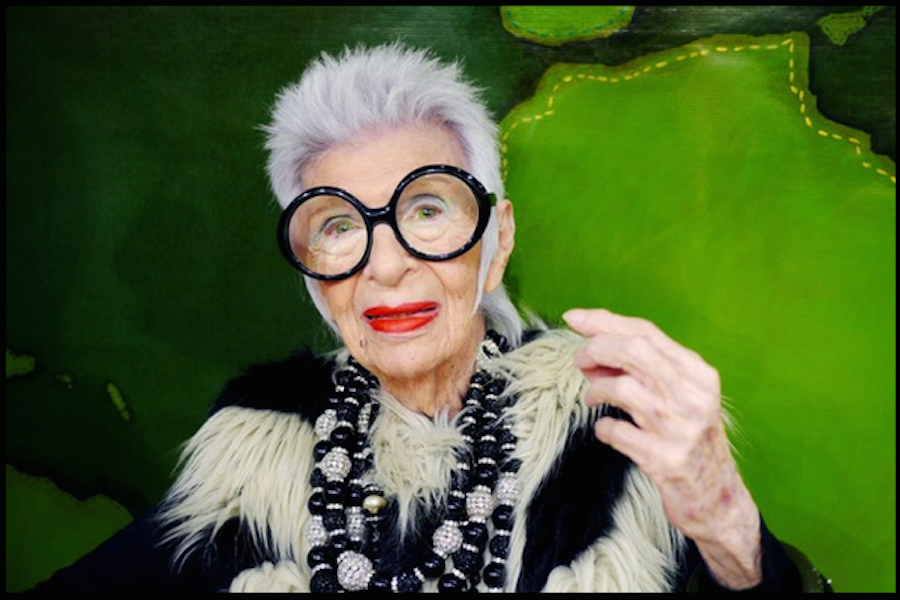Iris Apfel: Woman of Style and Attitude

“I never expected to have a one of a kind Barbie doll made in my image.”- Iris Apfel
As the saying goes: don’t judge a book by its cover. But in the case of Iris Apfel, Accidental Icon: Musings of a Geriatric Starlet, you should.
The vibrant cover photo is an invitation. It illustrates Iris Apfel, the 96-year-old style icon, peering at us in wonder through her iconic black, owl-framed glasses. She is dressed in a shiny green jacket accessorized with a plethora of chunky yellow, red and green bangles and necklaces. A peach-hued man’s tie is embroidered with a large pineapple. On anyone else, the look would be a joke but on Iris, it works. “Style is attitude,” she reminds me at her packed book signing at Bergdorf Goodman in New York City. “It’s not what you wear but how.”
We talk over a series of phone calls and meetings during the week of her book launch, which was the same week Mattel introduced the new Iris-styled Barbie. Lest the reader assume a fashion hero is superficial, to meet Iris is to realize that the opposite is true. A strong sense of self-possession and quick repartee is almost intimidating in person if it weren’t for her sense of humor. “If you don’t dress like others you don’t have to think like others,” she quipped.
“Whatever happened to the cultivation of an inner self?” she asks in her book. “It’s painful and it’s work, but it always pays off.” In the crowd at Bergdorf’s a number of her friends are dressed in Iris-spirited pairings of fabric and ornament reinforcing that she’s inspired a maximal genre. It feels contagious and liberating.
Why bother with a book at this point? “I wanted to write something not boring that would be accessible to all my young fans.” Judging by her Instagram account that number is significant; her followers number nearly a million.
The fandom was an unplanned result of a phone call. One day in 2005, Harold Koda, then-curator in charge of the Costume Institute at the Metropolitan Museum of Art, called to ask Iris if she would be willing to lend some of her wardrobe collection for an exhibit.
“I agreed because I thought all I had to do was place my things in beautiful cases,” she said. Ultimately accessories, as well as garments, were displayed, eighty ensembles total. Iris styled every one and loved it. The show was a blockbuster success with lines outside and down the stairs. She was surprised as much by how people reacted to her as how she reacted to them.
“Ralph Lauren walked through the show and said, “You’re so free. You’re so free.” Isn’t that personal expression?” she asked rhetorically. “Dressing,” she continued, “is a creative experience. Creativity is a great emotional release; it keeps you happy and healthy.”
Photos of the exhibit reveal glorious materials are the common element among all the looks. Fashioned into robes, jackets, slacks, skirts, blouses, slippers and dresses, often head to toe in unison, the textiles provide a unifying backdrop on which Iris layers her accessories. Some garments she designed, others she found in Parisian ateliers at the end of the season or wherever else she was. “I like a touch of the exotic,” she qualified. Likewise, the costume jewelry is a mix of high and low, from near and far. A critic said, “Before multiculturalism was a headline Iris was wearing it.”
“People often ask me about the genesis of my passion for fabric,” she says. As a little girl at family gatherings, her grandmother allowed her to play with bags full of sewing remnants and select six pieces to take home. Iris spent hours agonizing over her favorites and became obsessed with color, texture, and pattern. “It’s very clear playing this way honed my eye.”
With her husband, Carl, Iris co-founded the textile firm Old World Weavers to do meticulous reproductions of antique fabrics for high-end clients. Among the most prestigious were the nine White House Administrations they advised. Iris and Carl traveled year-round in Europe, North Africa, the Near and Middle East to source materials and work with mills. She loved the hunt whether in a museum archive or a souk. Long before this years’ Met Gala celebrated the Vatican’s closet and the Catholic Imagination, Iris was tailoring for herself a nineteenth century priest’s silk velvet chasuble, a kind of tunic, she found in a French flea market. “I started to collect them, which I suppose, is one avenue to building a wardrobe,” she says.
Rara Avis, the name of the museum exhibit, subsequently travelled to Florida, Massachusetts and elsewhere, changing Iris’ reasons for working. In the past, she followed her own muse but increasingly she found she was inspiring others to follow theirs. The University of Texas asked her to be a “visiting professor.”
“Students tell me I’ve changed their lives. It’s very satisfying,” she muses.
With her profile rising, advertisers called, such as MAC Cosmetics and Macy’s. They wanted her to help create limited editions as well as to be the face of brand. “I’m the oldest living broad that ever graced a major cosmetics campaign,” she joked. Then in 2015, when Albert Maysles released a documentary film, “Iris,” her wit and passion were visible to the world.
These days Iris sells a line of jewelry and fashion on the Home Shopping Network. “When I’m pedaling my creations, people call in and tell me I’ve made them think differently about dressing. It makes me happy,” she exclaims.
Her thoughts on age-defying beauty interventions? She quoted Coco Chanel, “Nothing makes a woman look so old as trying desperately hard to look young.” What about age-defying attire shopping? It’s an underserved market, she stated. “I wanted to open a very chic boutique on Madison Avenue called The Sleeve. Everything dressy is sleeveless and designed for very young women,” she observes.
Using imagination and common sense are two values Iris calls out as discounted by our addiction to digital devices. “A lot of women I’ve met in person say the same thing. If I have influenced them, I’d like to think it’s in a positive way-following your instincts, taking risks.”
Iris Apfel, Accidental Icon: Musings of a Geriatric Starlet is published by Harper Design.
Photo credit: Libby Parker
This essay was featured in the June 3rd edition of The Sunday Paper, Maria Shriver’s free weekly newsletter for people with passion and purpose. To get inspiring and informative content like this piece delivered straight to your inbox each Sunday morning, click here to subscribe.
READ MORE STORIES THAT MOVE HUMANITY FORWARD
READ MORE STORIES THAT MOVE HUMANITY FORWARD
SIGN UP FOR MARIA’S SUNDAY PAPER

